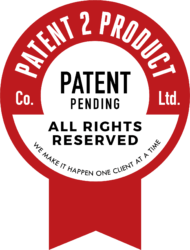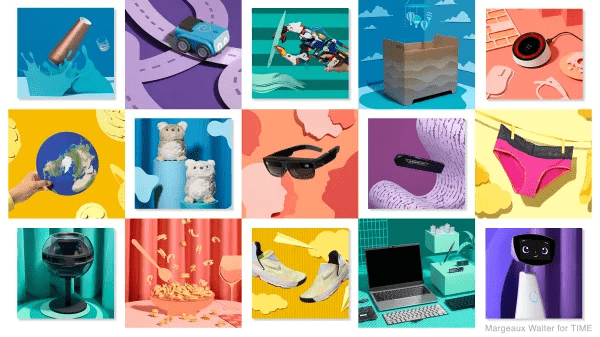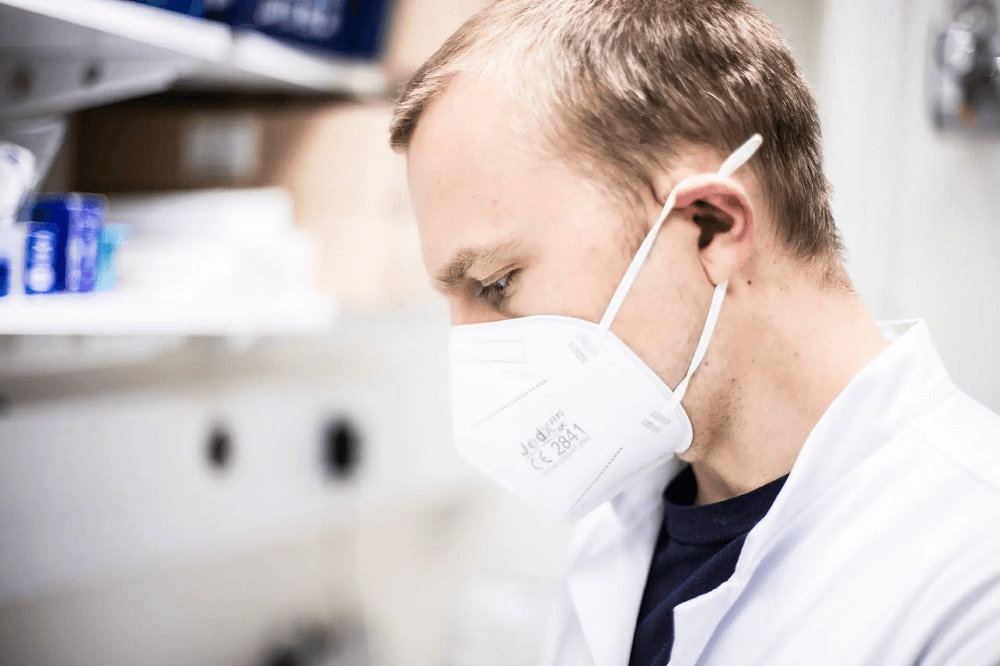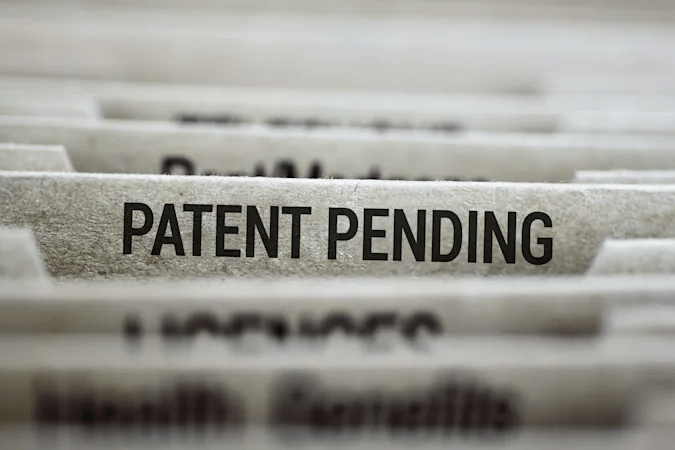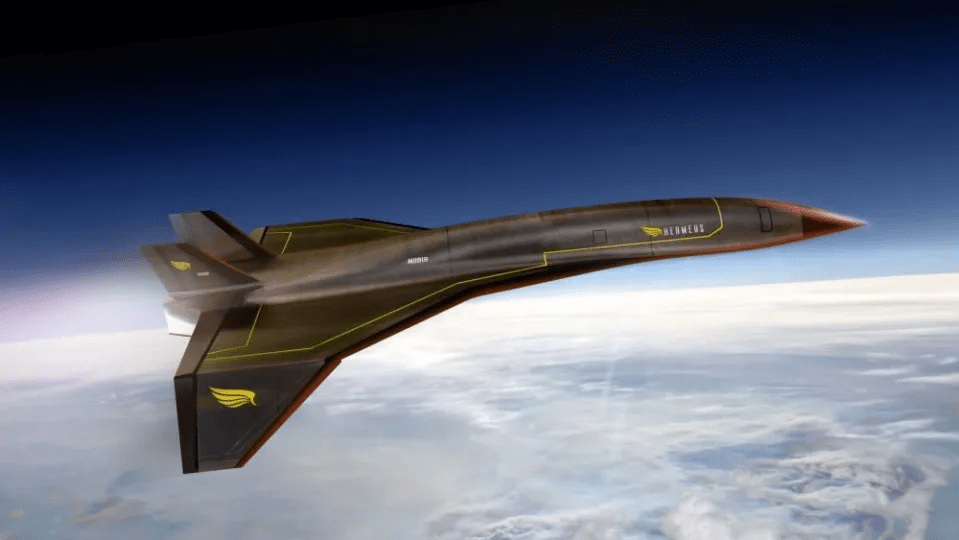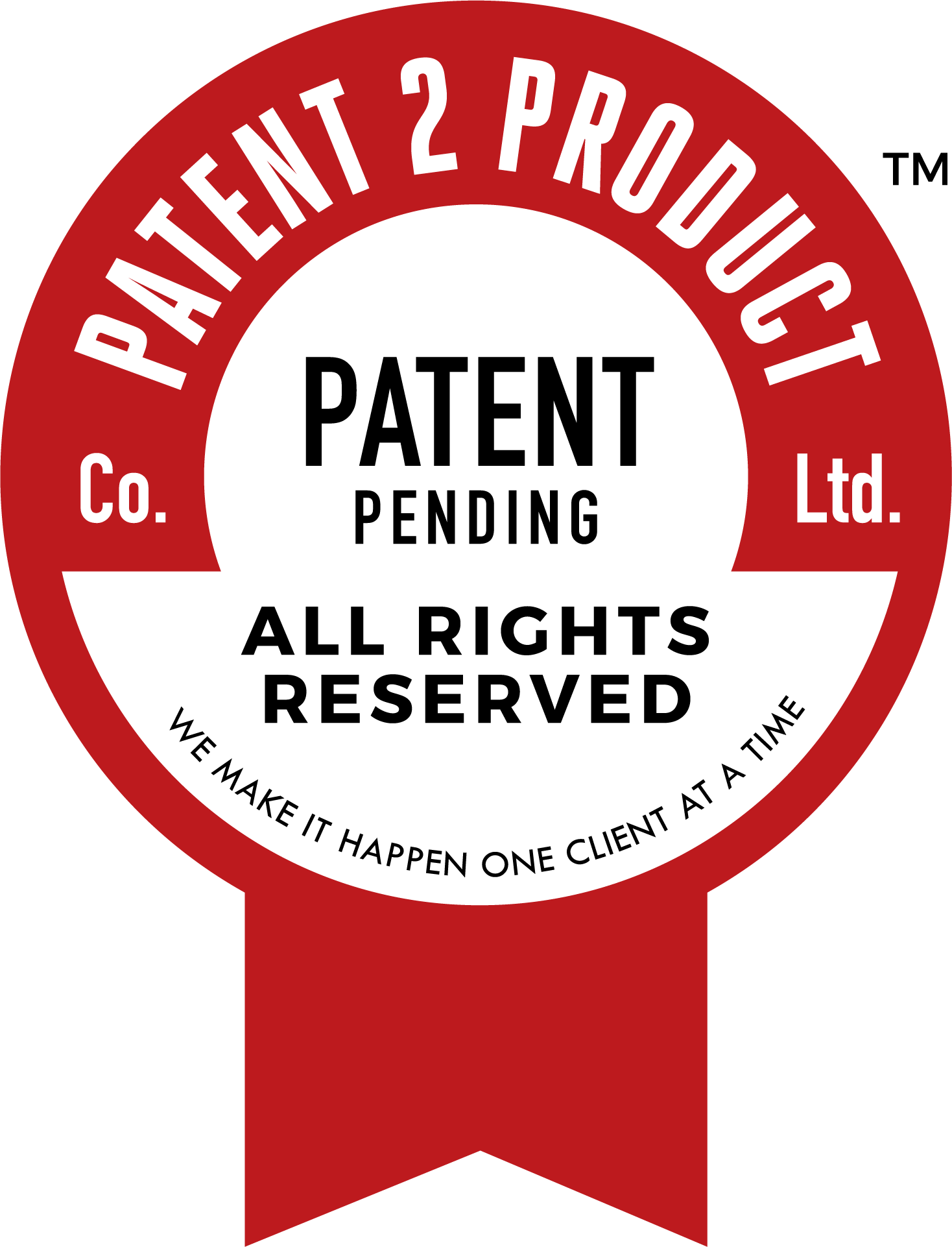Dream to reality: inventions come about through hard work and applied scientific knowledge

Curiosity and the ability to look at the world from fresh perspectives are a driving force for innovation and discovery. Three inventors working at Tampere University share the stories behind their inventions.
For most of us, a tattered plastic bag is ugly and worthless, but inventors see the world differently. A scrap of plastic attached to the door of a woodshed and swinging in the wind is an important indicator for Ilmari Tamminen.
“It shows me that the air is moving,” Tamminen says.
Tamminen studies staining and imaging techniques in the Faculty of Medicine and Health Technology at Tampere University. In lay terminology, his work entails dying cells and tissues so that their internal structures can be visualized using biomedical imaging.
“To put in another way, I am trying to figure out how to tap into the full potential of run-of-the-mill X-ray machines,” Tamminen describes.
Tamminen’s scientific creativity comes to life in a laboratory, but he is also excited about his homemade inventions. The family heats their home with wood and, since wood must be properly seasoned for it to burn well, Tamminen came up with an ingenious workaround to accelerate the drying process.
“I switched the hinges to the other side and wedged the door open at a specific angle. Now the door catches the wind blowing from a clearing and speeds up drying.”
The ingenuity of this invention lies in the simplicity of the idea. The way inventors approach the world around them is what sets them apart from the rest of us: when they see problems, their mind begins to see solutions.
“The key is having plenty of ideas but not falling in love with any of them. Ideas must be coolly assessed to determine what works and what does not. It is important to write down one’s thoughts and carry out bold experiments, because few of us will hit the jackpot right away, at least when working on large-scale projects,” Tamminen says.
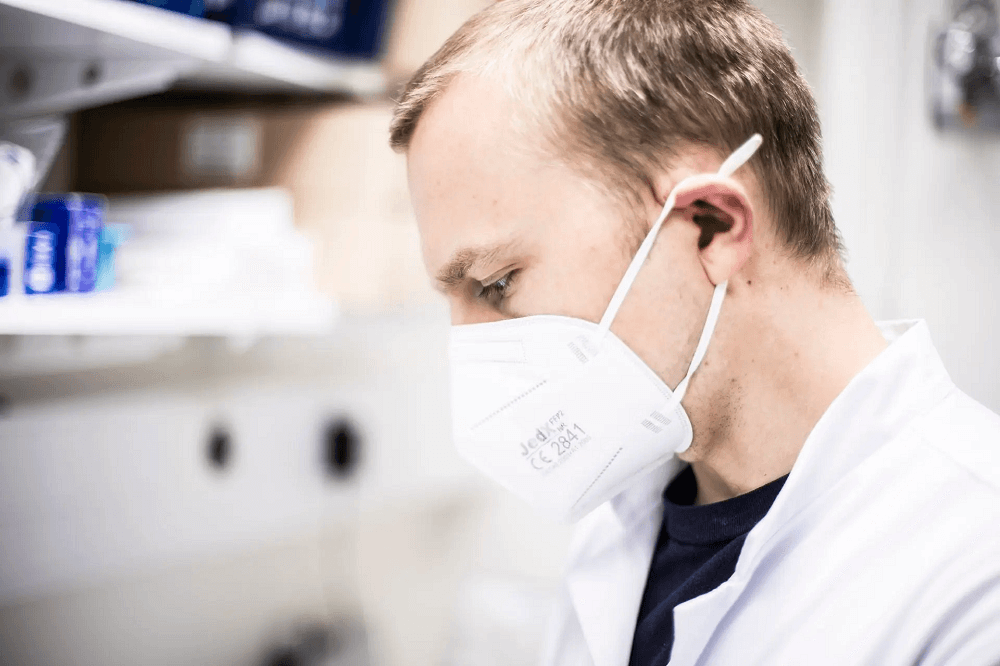
Matching a problem with a solution
In 2020, Industry Professor Tero Joronen was presented with Tampere University’s Inventor of the Year Award. Joronen has always wanted to look at the world with fresh eyes. His inquiring mind has resulted in a number of patents – last year alone, Joronen invented or co-invented ten inventions. Joronen has come up with most of his inventions while working in industry, Valmet to be specific, and the rest in academia.
“The first step is to identify a problem and describe it in clear and simple terms. A complex problem requires a complex solution,” Joronen points out.
Joronen is naturally curious and more or less constantly looking for ways to improve things. While most of his inventions are in the field of heavy industry, inventing is also a hobby for Joronen. His home is full of small labour-saving innovations.
“The joy of discovery fuels my passion for inventing. I get a kick out of creating something new. And I have always had a lively imagination,” he muses.
Every other application results in a patent
In total, 1,685 patent applications were submitted in Finland in 2020, the largest number in the past five years. The vast majority of patent applications are filed by large industrial companies, such as Valmet where Joronen works.
There are two reasons: these companies make R&D a priority and have money to spend on it. Turning an idea into a patent costs a minimum of €10,000 in Finland but applying for patent protection abroad will multiply the costs. Patent agent and attorney fees are the largest single item of expenditure.
“The number of patent applications seems to be levelling off after years of steady decline, but why this is happening is anyone’s guess. Of all applications filed, roughly 50% result in a patent,” says Olli Sievänen, head patent advisor in the Finnish Patent and Registration Office.
Scientific knowledge and expertise both spark and steer innovation.
Creativity is an important quality for engineers, too
Pasi Keinänen, project manager in the Faculty of Engineering and Natural Sciences at Tampere University, has a brain that looks at problems but sees opportunities. When Keinänen once again hoovered up pieces of his children’s Lego, a pedagogically oriented father might have reminded his children to tidy up after themselves. Being an accomplished inventor in the field of nanotechnology and having worked as an IP advisor at Tampere University, Keinänen had a different approach: he modified the vacuum cleaner. By manipulating airflow, Keinänen was able to separate Lego from dust, and vacuuming is now a breeze. Physicists know how this is done. We non-physicists might not, no matter how hard we try (Keinänen tried to explain it – to no avail).
“Scientific knowledge and expertise both spark and steer innovation. For example, the vacuum cleaner modification would not have been invented had I not been familiar with the basics of physics,” Keinänen notes.
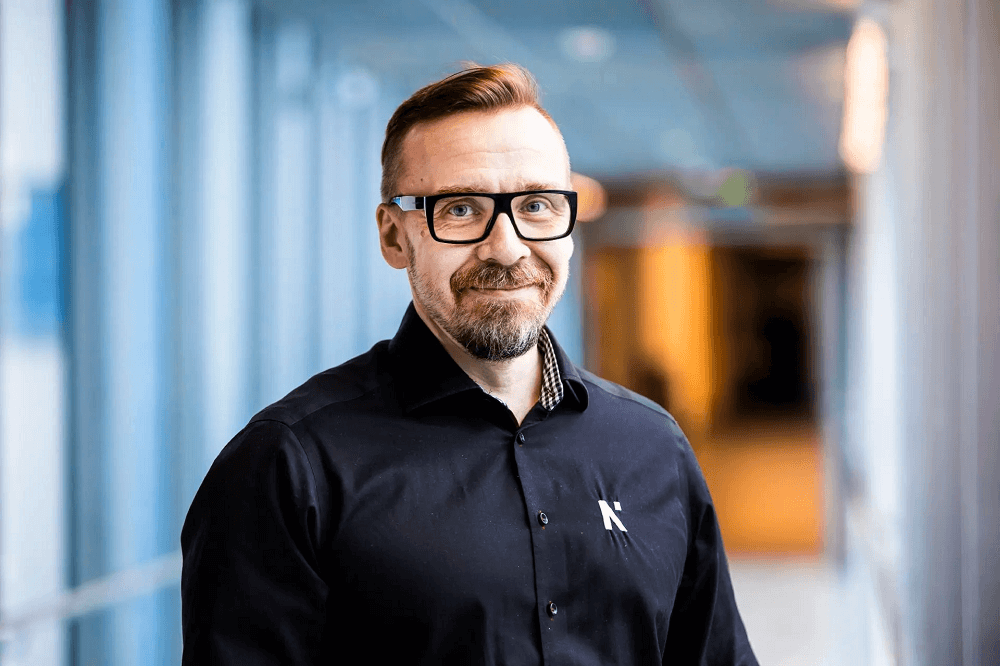
Tero Joronen agrees. He says that inventing is 10% brainstorming and 90% experimentation, the application of knowledge and hard work.
“Creativity is often associated with artistic occupations, but I find that pursuing a career in engineering also requires a great deal of creativity. Creativity is about rethinking the basics of engineering sciences to create something new,” Joronen says.
Your idea has already been invented – so keep working!
All three are familiar with the painful disappointment of coming up with an amazing idea only to discover that it already exists. So many great things have already been invented.
“There is a limit to the amount of information the brain can store. When being hit with a brainwave, one cannot be aware of all the information that is, for example, available online. I sometimes wonder why all the great ideas out there are not being exploited to their full potential. But we have to keep working and pushing the boundaries,” Tamminen says.
The number of patents illustrates the level of commercial awareness in a university.
Being in the zone is a sign that a breakthrough is close
The journey from an idea to an invention depends on the inventor. During a typical workday, Ilmari Tamminen switches between studying biomedical stains and imaging, thinking and testing. He combines his theoretical knowledge and scientific expertise with observations and thinking outside of that famous box.
“I compare my ideas to the existing body of knowledge and move from there,” Tamminen describes.
The theories will either work or not, but it is Nature that decides the outcome, not anyone’s opinion.
“There is this exhilarating moment of discovery when you witness a hypothesis coming to life in a test tube,” Tamminen adds.
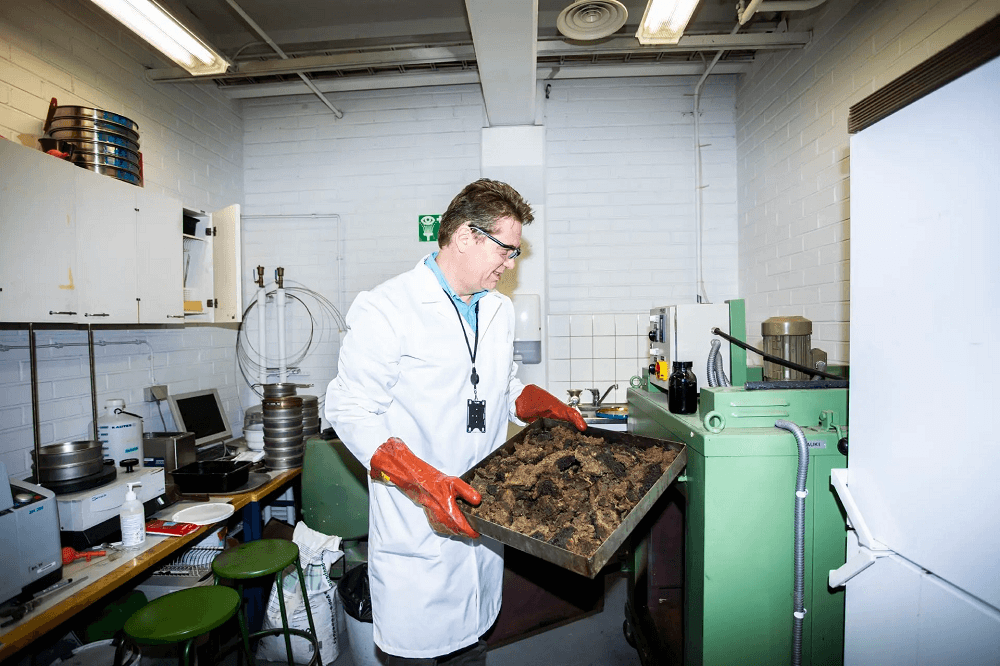
All the three inventors inherited their inventive streak, but the ability to see the world from a different perspective can also be learned. Tero Joronen’s method of choice is to tune his mind to a specific frequency.
“As comical as this may sound, it is almost a trance-like state. I close off the outside world to create imaginary visions and try to see beyond the ordinary. Inventing is more about intuition than analytical thinking, but a useful result depends on an interplay between analysis and creativity,” Joronen says.
Women are not inventors, or are they?
The gender gap in patenting reflects the educational and career choices of men and women.
“As a whole, there are more men in the world of inventing,” Olli Sievänen says.
According to the World Intellectual Property Organization (WIPO), 16.5% of inventors named in patent applications were women in 2020. In the past 20 years, the number of patent applications that name at least one female inventor has increased from 20% to 35%.
Biotechnology, chemistry and new drug development are the sectors with the highest proportion of female inventors. More than 59% of the patents related to these fields have at least one female inventor.
The design of mechanical components and engines was at the bottom of the list, with less than 18% of patents having at least one female inventor. Overall, one in four patents is granted to women.
“There are more men working in technology and engineering, and the majority of patent applications are related to these fields. For example, construction engineering and IT are both male-dominated and patent-active sectors in Finland,” Sievänen says.
An invention does not equal important research.
The chances of being issued a patent largely depend on one’s field of research. It is not about supremacy or the degree of creativity and ambition.
“Patents are granted to inventions that can be utilised and scaled up to industrial proportions,” Pasi Keinänen says.
“Breakthroughs and new ways to conduct research are being continuously discovered by social scientists. And while it is incredibly difficult to obtain patent protection for an effective new psychological treatment, it can greatly help large numbers of people and also generate new business,” he adds.
Patents are a barometer for academia

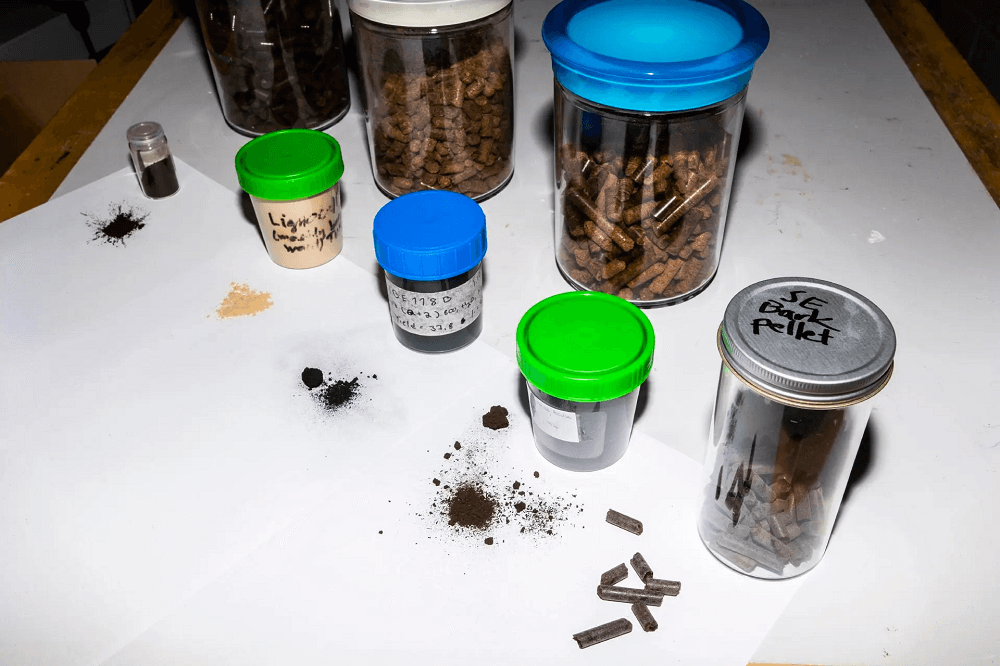
Innovation activities are geared towards making money in the corporate world, but an innovation-oriented approach should also be increasingly embraced in academia, Pasi Keinänen finds. If researchers lack commercial awareness, their inventions may not be placed in the public domain to benefit others.
“Patents are like a barometer for the academic world. The number of patents illustrates the level of commercial awareness in a university. In this respect, the Nordic countries are lagging behind Central Europe,” Keinänen says.
Broadly speaking, the innovation activities of universities are about reconciling academic values with industry needs and sharing world-class Finnish expertise with the rest of the world. Innovative companies need professionals with an innovative mindset.
Tamminen points out that inventions cannot be used for assessing the importance of research. However, an invention can be both a scientific discovery and a commercial success.
“An invention could function as a confirmation of quality and relevance if someone is willing to pay for the results of scientific thinking. This type of integrated career would be my all-time invention,” Tamminen says.
Cargo ships are so full that ports are struggling to unload them

Cargo ships are piled higher with containers than they’ve ever been, according to data from analyst firm IHS Markit. And the crowding is worst onboard ships sailing into US west coast ports. At the Port of Long Beach, which has been mired in record backlogs for months, the average ship now brings in 7,000 containers—up 70% from the pre-pandemic average of roughly 4,000 containers.
The glut of containers is overwhelming strained port infrastructure, especially at older ports like Long Beach in Southern California which already faced frequent delays, according to Turloch Mooney, the associate director for maritime and trade analysis at IHS Markit. “Quite a few of those ports have really gone beyond the breaking point now,” he said. “That would be what you’re seeing on the US West Coast.”
The overstuffed container ships are both a symptom of the global economy’s supply chain woes and a new factor exacerbating the gridlock at ports and contributing to shortages and shipping delays. They offer yet another example of the fragility of supply chains designed to be as lean and efficient as possible: With little margin for error, ports have been unable to handle the sudden deluge of containers coming off each tightly packed ship.
The resulting delays will likely create pains for shoppers throughout the holidays and continue in some form until businesses begin building more wiggle room into their supply chains and the US updates its aging infrastructure.
The forces overloading the world’s ports
Two long-term trends have been inflating the number of containers loaded or unloaded on the average ship—also known as the ship’s “call size”—even before the pandemic. First, container ships are getting bigger, which has dramatically increased their maximum capacity. Second, the shipping industry has consolidated: just 10 companies that now control 80% of all shipping. These (more profitable) shipping giants are using their market power to make their shipping routes as efficient as possible (for them) which means filling their ships as close to maximum capacity as possible.
Then the pandemic kicked this into overdrive. Demand for consumer goods rose, especially via e-commerce, straining supply chains. Space onboard container ships became scarce and expensive, which incentivized shipping lines to cram every available inch with cargo to maximize the amount of revenue they could squeeze out of their slow, arduous journeys through backlogged ports.
More cargo, more problems
The problem is infrastructure: Ports simply aren’t built to unload ships carrying so many containers. “It’s a big stress factor,” said Mooney.
Every berth at a port has a fixed number of cranes, whether a ship comes in with 1,000 containers or 10,000. That means ports can’t ramp up their capacity to meet the demands of ships carrying more containers. Similarly, shipyards have limited space to stack and sort containers. The more containers, the greater the logistical challenge of stacking, unstacking, and restacking containers to keep them organized.
More bottlenecks wait just outside the port. Roads and highways leading into a port may not have enough capacity to handle the surge of trucks that come in to pick up or drop off containers when a tightly packed ship comes in. The intermodal terminals connecting ports and railroads may also get clogged with the sudden spike in traffic.
In general, Asian ports have been better able to handle the surge in containers. That’s partly because Asian ports tend to be decades newer than North American ports, says Mooney, built during the era when ships carried smaller cargo loads. Labor is also cheaper and less protected in countries like China, which makes it easier for ports to hire more workers and switch to 24-hour operations whenever they have a backlog. A third factor is that Asian ports focus on exporting while North American ports do more importing. It’s simpler for ports to load exports compared to the logistical challenge of unloading imported containers onto trucks and trains bound for different destinations.
UK appeals court rules AI cannot be listed as a patent inventor
Add the United Kingdom to the list of countries that says an artificial intelligence can’t be legally credited as an inventor. Per the BBC, the UK Court of Appeal recently ruled against Dr. Stephen Thaler in a case involving the country’s Intellectual Property Office. In 2018, Thaler filed two patent applications in which he didn’t list himself as the creator of the inventions mentioned in the documents. Instead, he put down his AI DABUS and said the patent should go to him “by ownership of the creativity machine.”
The Intellectual Property Office told Thaler he had to list a real person on the application. When he didn’t do that, the agency decided he had withdrawn from the process. Thaler took the case to the UK’s High Court. The body ruled against him, leading to the eventual appeal. “Only a person can have rights. A machine cannot,” Lady Justice Elisabeth Laing of the Appeal Court wrote in her judgment. “A patent is a statutory right and it can only be granted to a person.”
Thaler has filed similar legal challenges in other countries, and the results so far have been mixed. In August, a judge in Australia ruled inventions created by an AI can qualify for a patent. However, only earlier this month, US District Judge Leonie M Brinkema upheld a decision by the US Patent and Trademark Office that said “only natural persons may be named as an inventor in a patent application.” Judge Brinkema said there may eventually be a time when AI becomes sophisticated enough to satisfy the accepted definitions of inventorship, but noted, “that time has not yet arrived, and, if it does, it will be up to Congress to decide how, if at all, it wants to expand the scope of patent law.”
China accounts for 40% of 6G patent applications with most of them being filed by Huawei, survey reveals
China is already working on the next generation of communication networks known as 6G that is expected to roll out commercially by the end of this decade.
Research conducted by Nikkei Asia and Tokyo-based research company Cyber Creative Institute shows that China topped the list with 40.3% of 6G patent filings, closely followed by the U.S. with 35.2%. Japan ranked third with 9.9%, followed by Europe with 8.9% and South Korea with 4.2%.
Around 20,000 patent applications for nine core 6G technologies were surveyed for this. This includes communications, quantum technology, base stations, and artificial intelligence. Countries with a greater number of patent filings are more likely to be ahead of the curve in terms of advanced technology and tend to have a greater influence over industry standards.
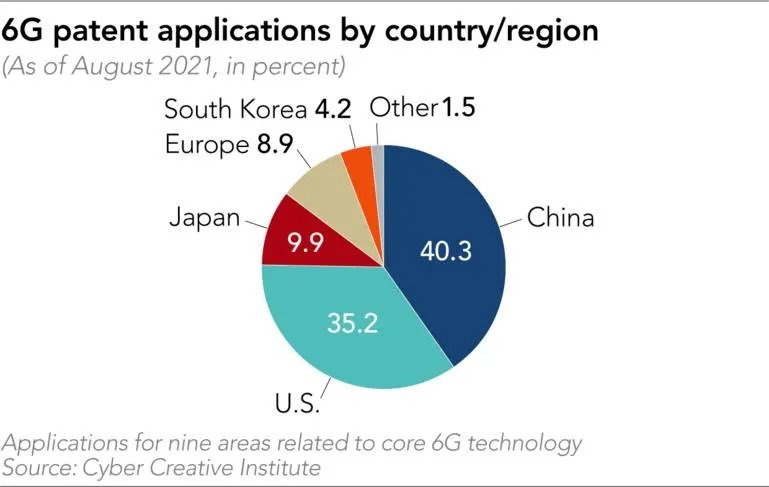
China’s 6G development had been expected to be slow due to sanctions imposed by the US government in 2019 on Huawei Technologies but, the Asian country has maintained its competitiveness by mobilizing state-run companies and universities.
6G patent applications by China are mostly related to mobile infrastructure technology. This makes sense considering aerial coverage such as satellites, combined with ground base stations for broader radio bands, will be needed in the 6G era.
A considerable amount of the patents (12%) have been filed by none other than Huawei which controlled 30% of the world’s base stations in 2020. Other prominent patent holders include state-run companies such as State Grid Corporation of China and China Aerospace Science and Technology.
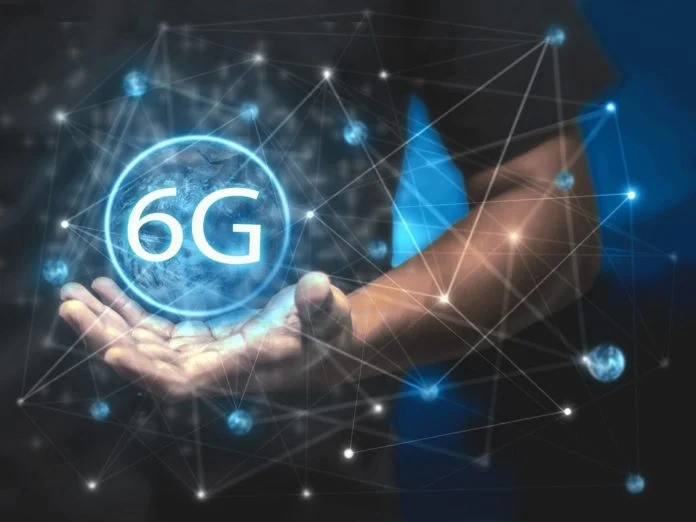
6G is expected to be over 10 times faster than 5G and will be enabling fully autonomous driving, HD virtual reality, and worldwide internet, even in the most remote regions.
On the other end, the US has high technical prowess in software and terminals, thanks to it possessing many smartphone and internet companies. Qualcomm and Intel have acquired many patents for chips used in smartphones and other IT equipment.
Finally, Japan that ranks third in the number of patents, has Nippon Telegraph & Telephone. Nippon has filed many patents involving optical communications and mobile infrastructure networks in urban areas. This includes technologies for mitigating data congestion and delays.
The International Telecommunication Union and industry groups will likely begin discussing 6G standardization around 2024. China is expected to have a strong voice in the policy-making process thanks to the large number of patents owned by it.
Judge Says an AI Can’t Be an Inventor on a Patent Because It’s Not a Person
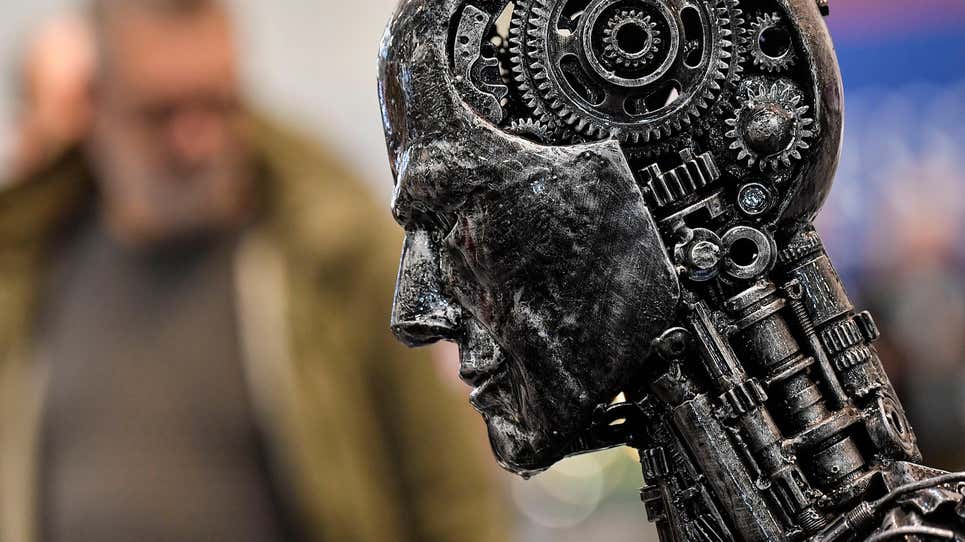
It all boils down to how the law defines an 'individual.'
Don’t worry, humans—artificial intelligence systems aren’t taking over the world yet. They can’t even appear as inventors on U.S. patents.
U.S. federal judge Leonie Brikema ruled this week that an AI can’t be listed as an inventor on a U.S. patent under current law. The case was brought forward by Stephen Thaler, who is part of the Artificial Inventor Project, an international initiative that argues that an AI should be allowed to be listed as an inventor in a patent (the owner of the AI would legally own the patent).
Thaler sued the U.S. Patent and Trademark Office after it denied his patent applications because he had listed the AI named DABUS as the inventor of a new type of flashing light and a beverage container. In various responses spanning several months, the Patent Office explained to Thaler that a machine does not qualify as an inventor because it is not a person. In fact, the machine is a tool used by people to create inventions, the agency maintained.
Brikema determined that the Patent Office correctly enforced the nation’s patent laws and pointed out that it basically all boils down to the everyday use of language. In the latest revision of the nation’s patent law in 2011, Congress explicitly defined an inventor as an “individual.” The Patent Act also references an inventor using words such as “himself” and herself.”
The judge also rejected Thaler’s claim that the Patent Office had to provide evidence that Congress did not want to exclude AI systems from being inventors.
Furthermore, Brikema stated that the nature of an inventor has already been examined in federal courts, which have ruled that neither companies nor states can claim to be inventors on a patent.
For his part, Thaler also tried to argue that the court should respect Congress’ intent to create a system that would “encourage innovation.”
“Allowing patents for AI-Generated Inventions will result in more innovation. It will incentivize the development of AI capable of producing patentable output by making that output more valuable…” Thaler said. “By contrast, denying patent protection for AI-Generated Inventions threatens to undermine the patent system by failing to encourage the production of socially valuable inventions.”
Nonetheless, Thaler didn’t have luck with that argument, either. Brikema said that these were policy considerations and thus must be dealt with by Congress, not the courts.
And it’s not like the Patent Office is refusing to consider what role, if any, AI should have in patents. It has requested comments artificial intelligence in patent policy and reported that the majority of responses reflected the belief that current AI “could neither invent nor author without human intervention.”
Ryan Abbott, a law professor who oversees the Artificial Inventor Project, told Bloomberg the group would appeal. Although Brikema squashed all of the project’s arguments, she didn’t say an AI could never be listed as an inventor.
Malaysian students invent device that makes ocean water drinkable for ‘sea nomads’
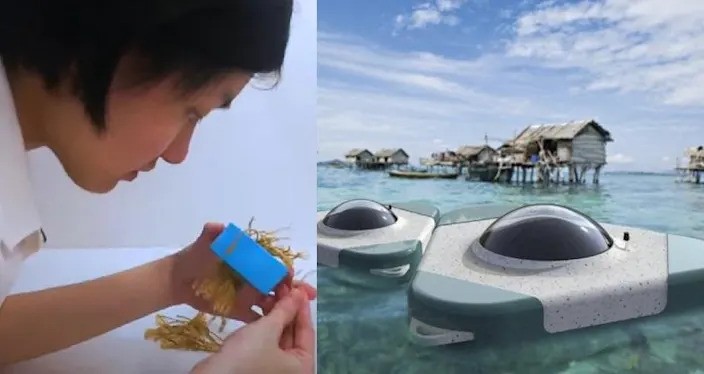
An invention that could provide clean drinking water to "sea nomads" — communities living near the ocean — has earned three Malaysian students a spot to compete at the James Dyson Awards, an annual competition that recognizes young design engineers with inventive solutions to real-world problems.
Malaysia’s best: Asia Pacific University of Technology & Innovation (APU) sophomores Bennie Beh Hue May, Loo Xin Yang and Yap Chun Yoon won the top prize of 10,000 Malaysian Ringgit ($2,400) in Malaysia’s search for its official entry to the international design competition, MalayMail reported.
- The product design students bested 120 other participants with their sustainable seawater desalination pod called the “WaterPod.”
- Eighty-four international finalists are now vying for a chance to win the top prize of $40,000, with an additional $6,600 for the winners’ university.
- According to the James Dyson Awards website, Dyson engineers will narrow the competitors down and announce a shortlist of the top 20 contestants on Oct. 13.
How WaterPod works: The invention utilizes a self-cleaning solar desalination system, which facilitates seawater absorption through a wick. It has a special semi-spherical cover exposed to sunlight that collects vapor, which eventually condenses into a potable liquid.
- The desalinated water then flows into a storage chamber that can hold between 8 to 10.5 gallons (30.28 to 39.75 liters), which users can then collect using a pump.
- In their online pitch, the students describe the WaterPod as an alternative to bigger desalination plants, since it “is designed to be simple and only uses basic science” to do the same process.
- The students came up with the device’s floatation concept after studying the needs of local communities living near the sea, like the Bajau tribe in Sabah.
- Eekang Ooi, a lecturer affiliated with a nonprofit that helps sea nomads, inspired the students to pursue the project.
Why this matters: Sea nomads, who live on the coasts and islands in Southeast Asia, reportedly collect rainwater or barter tap water wherever and whenever they can due to lack of access to clean water.
Forget Supersonic. This Hypersonic Jet Can Fly From NYC to London in Under an Hour.
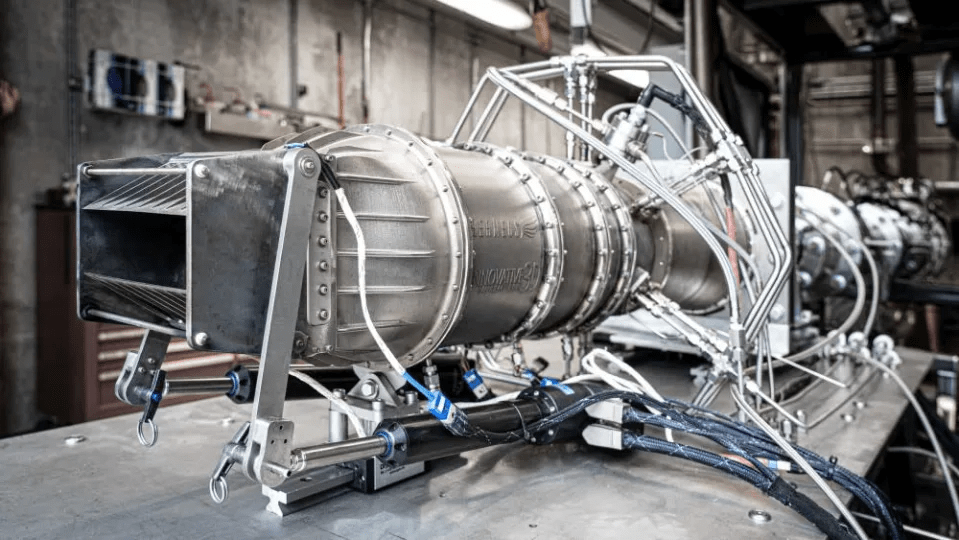
J. George Gorant
Supersonic flight is arriving—in a hurry. In the last 18 months, Boom has successfully tested its XB-1 demonstrator aircraft and pre-sold 15 of its still-in-development 30-seat Overture models to United Airlines. Virgin Galactic and Rolls Royce rolled out a partnership to develop a 19-seater. Even the Russian Federation revealed plans to build a supersonic jet for commercial use.
Then there’s the Hermeus Quarterhorse. Think supersonic or Mach 1—the speed of sound—multiply by five and you have the hypersonic Quarterhorse.
More from Robb Report
- United Airlines Is Buying 100 Zero-Emission Electric Planes From a Swedish Startup.
- Concorde 2.0? Inside the Wild Race to Launch a New Era of Supersonic Jets.
- Boom! United Airlines Just Bought 15 Supersonic Jets That Fly on 'Sustainable' Fuel.
Last week, the Atlanta-based company announced a $60 million award from the US Air Force to finance testing of the aircraft. Like the Greek god Hermes, this Hermeus is designed to travel seamlessly between worlds, with a projected top speed of Mach 5.5—or 4,219 mph. That makes it the fastest reusable aircraft on the planet, so a New York-to-London flight will take less than an hour.
Belly of the beast: The Quarterhorse’s engine is based on the GE J85 turbo jet, but has been modified to reach hypersonic speeds. – Credit: Courtesy Hermeus
Belly of the beast: The Quarterhorse’s engine is based on the GE J85 turbo jet, but has been modified to reach hypersonic speeds. – Credit: Courtesy Hermeus
Courtesy Hermeus
The speed will come from a unique engine set-up, a turbine-based combined cycle (TBCC) propulsion system. Such systems use a standard jet engine for launch and landing and to build enough speed in flight to feed air into a second turbine—known as a ramjet or scramjet—which produces more power, but requires high-speed air flow in order to ignite. The difficulty is managing the transition between the turbines and achieving the necessary aerodynamics.
Hermeus is off to a good start. In nine months, it designed, built and tested its engine, which is based on GE J85 turbo jet, and it has two advantages when it comes to testing. The Quarterhorse will fly autonomously, so the development team can get prototypes in the air and learn from them without risking pilots’ lives.
Strange 3D-printed shapes test 150-year-old mathematical theory
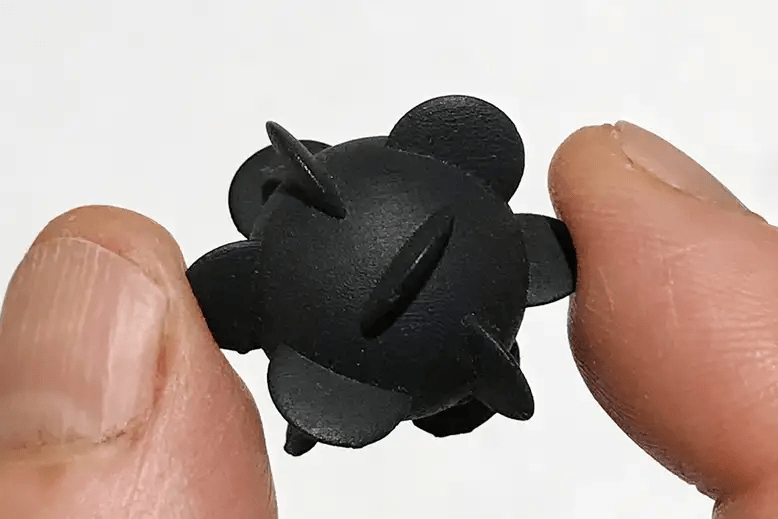
A strange shape described by mathematician Lord Kelvin in 1871 and predicted to behave unusually in a fluid has finally been fully studied in the real world thanks to 3D printing – and it seems Kelvin may have been wrong. The behavior of the shape, called an isotropic helicoid, has been described in fluid dynamics textbooks, but it hadn’t been directly measured until now.
An isotropic helicoid must experience the same amount of drag from a fluid regardless of its orientation, like a sphere, but also rotate as it moves through the fluid. So if you dropped an isotropic helicoid into a tank of a viscous liquid, it should spin as it sinks, similar to the way a propeller turns.
Greg Voth at Wesleyan University in Middletown, Connecticut, and his colleagues 3D printed five different shapes that should be isotropic helicoids, each a little more than a centimetre across, and dropped them into a tank of silicone oil. They were unable to detect rotation in any of them, meaning the predictions for an isotropic helicoid may be wrong.
“You’ve got to guess that somebody else has tried this in 150 years – in Kelvin’s original paper, it even sounds like he tried it,” says Voth. “I suspect that people have tried to fabricate these particles, but they were limited by defects in the fabrication so they simply didn’t publish, so the hypothesis of this behaviour has stayed with us.”
Upon delving into the hydrodynamic effects in play, the researchers calculated that there was almost certainly a link, or coupling, between the movement and rotation of their particles, meaning they fulfilled Kelvin’s criteria. But this was far too small to have any detectable effect.
“The coupling is tiny, but it still exists,” says Voth. He and his team are now working on building an isotropic helicoid where that coupling could be measurable, which would finally vindicate Lord Kelvin’s idea.
The World’s Oldest Bottle of Whiskey Just Sold for $137,500
Carbon dating says the spirit was likely bottled between 1763 and 1803.
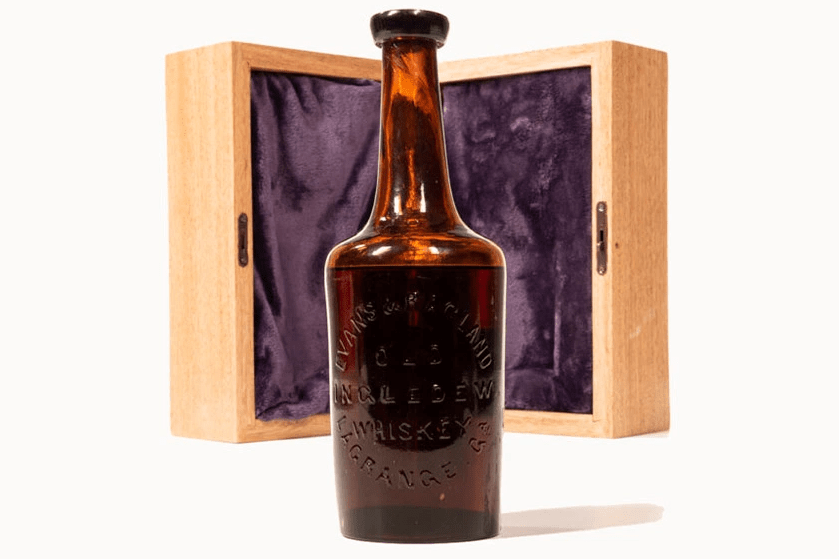
A bottle containing what is believed to be the world’s oldest whiskey just sold for way more than anyone was expecting.
The handle of Old Ingledew Whiskey went for a staggering $137,500 on Wednesday following a spirited round of bidding overseen by Skinner Auctioneers, reports CNN. The gavel price absolutely shatters the $20,000 to $40,000 the spirit had been expected to sell for before the sale.
So why did this bottle, go for nearly $100,000 more than its high-end estimate? One reason: its age. Though the whiskey was long thought to date back to 1850, a recent laboratory test conducted by the University of Georgia and University of Glasgow revealed it’s actually much older. A sample of liquid was taken from the bottle and carbon tested; the results revealed an 81.1 percent likelihood that the whiskey was actually bottled between 1763 and 1803, putting it in the historical context of the Revolutionary War and Whiskey Rebellion.
This particular bottle of Old Ingledew also has an interesting backstory. It once belonged to Wall Street financier John Pierpoint Morgan, the founder of what would eventually become JP Morgan Chase & Co., who obtained the whiskey on a business trip to Georgia, according to Barron’s. But he was far from the bottle’s only famous owner. His son Jack gifted the bottle to future US Supreme Court justice and South Carolina governor James Byrnes in the early 1940s. Jack also gave two other bottles to Franklin D. Roosevelt (they were distant cousins) and Harry S. Truman. Skinner’s rare spirits expert, Joseph Hyman, said that the bottle that sold this week is only one that survives.
As shocking as the bottle’s final price may be—it’s not often that a lot sells for more than three times its pre-auction estimate—it doesn’t make Old Ingeldew the world’s most expensive whiskey. Far from it, in fact. That title currently belongs to a bottle of Macallan Fine and Rare 60-Year-Old 1926 that sold for $1.9 million in 2019. But the title of world’s oldest? That belongs to this bottle and this bottle alone.
